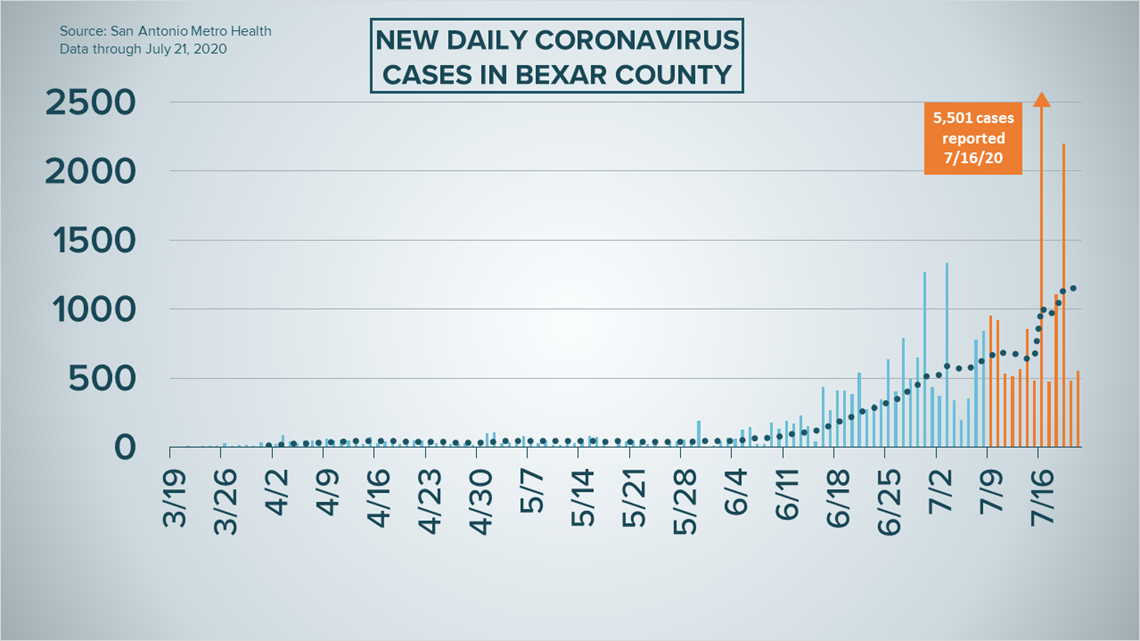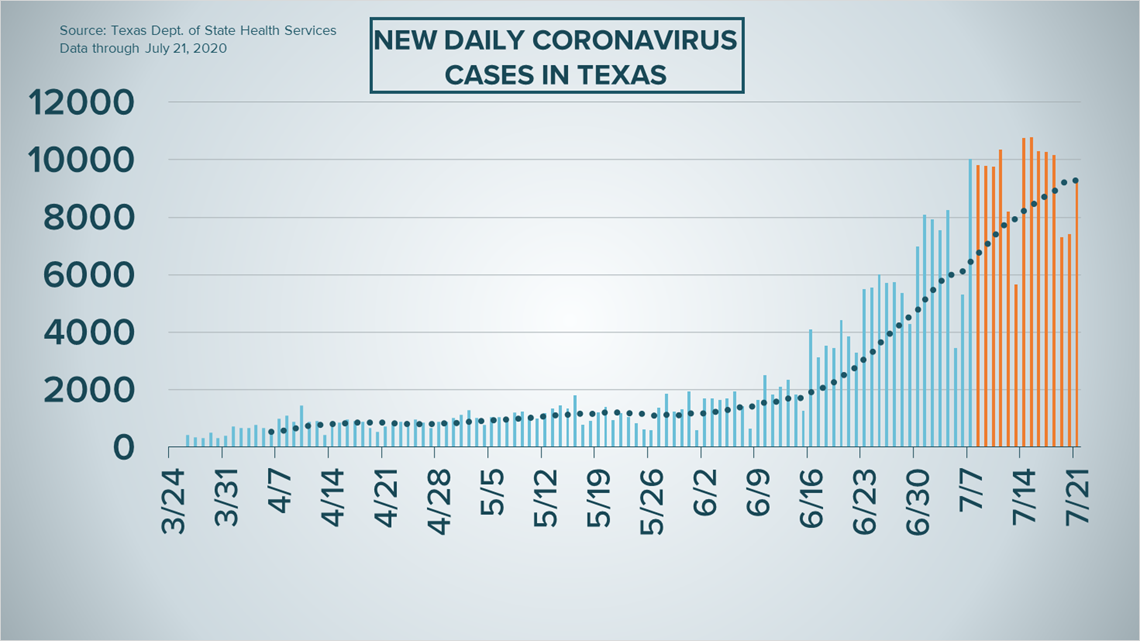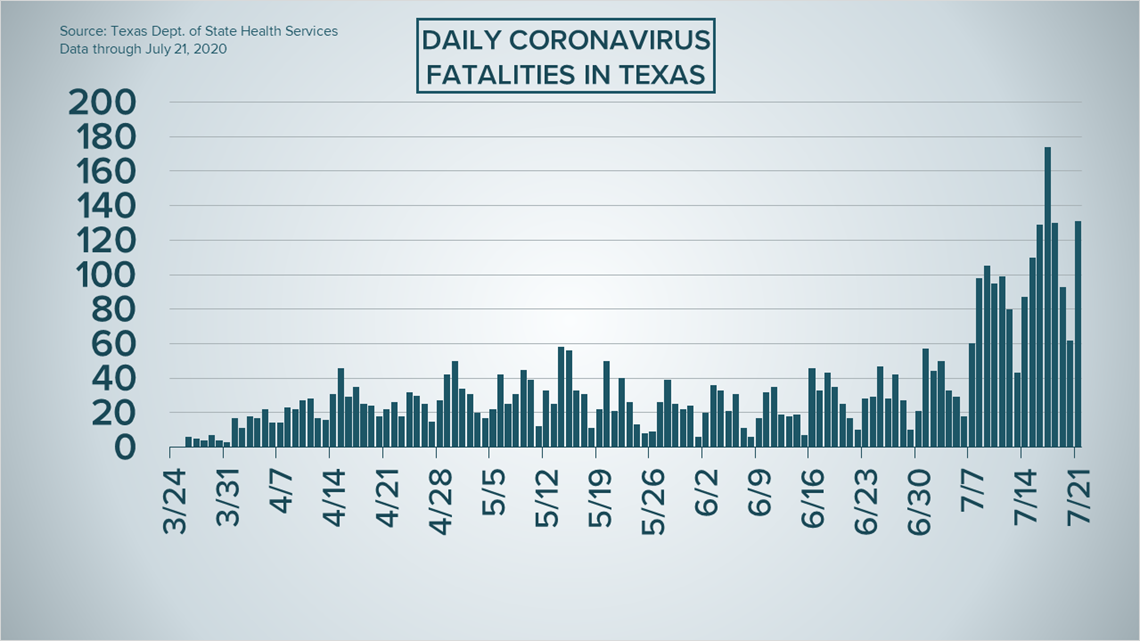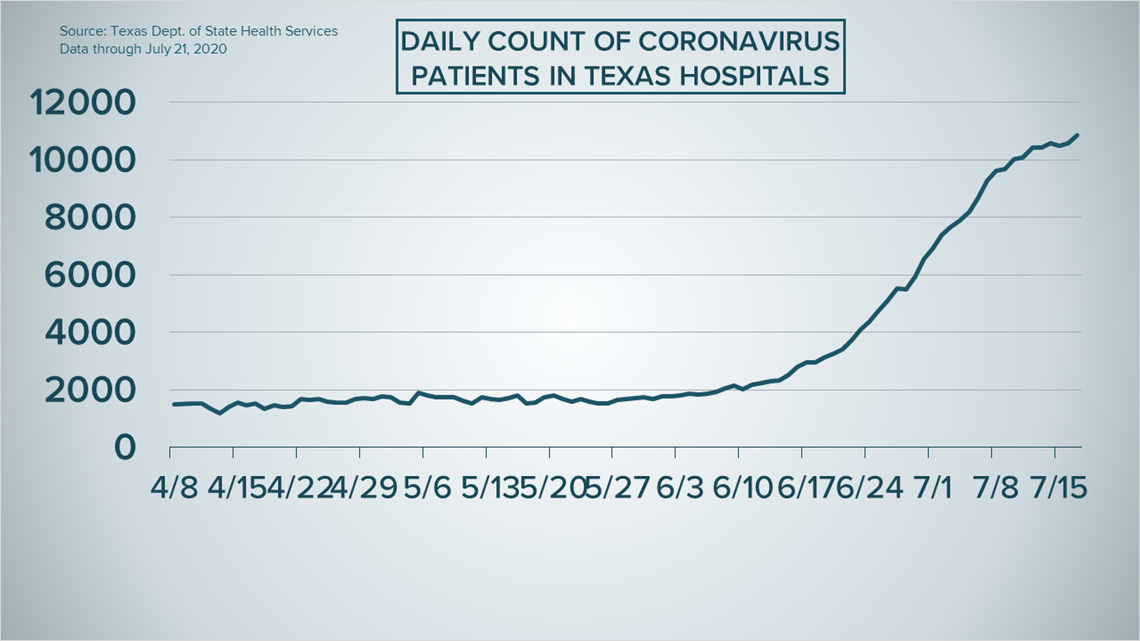SAN ANTONIO — We're tracking the latest numbers from the coronavirus pandemic in San Antonio and across Texas. Here are the latest numbers reported by Bexar and surrounding counties:
- Bexar County: 551 new cases and 12 fatalities from COVID-19 were reported Tuesday. There have been a total of 31,867 cases and 274 virus-related fatalities in the county.
- Comal County: Six new deaths were reported on Wednesday by the county. The deaths were all from nursing homes and include a woman in her 60's, two woman in their 70's, a man and woman in their 80's and a man in his 90's. There have been a total of 43 virus-related deaths in the county. There have been a total of 1,804 cases with 57 new cases reported Wednesday.
- Hays County: As of July 20, the Hays County Local Health Department confirms there are at least 3,080 active lab-confirmed cases of COVID-19. Since Hays County first started providing numbers, a total of 3,979 lab-confirmed cases have been reported, including 17 deaths.
How Bexar County is trending:
We're tracking how many coronavirus cases are confirmed in Bexar County each day from the time San Antonio Metro Health began reporting cases more than two months ago. Graphing those daily case numbers along a 14-day moving average provides an accurate picture of the curve in the San Antonio area and the direction we're heading amid the coronavirus.
On Tuesday, Mayor Ron Nirenberg reported an additional 551 confirmed and probable cases of COVID-19 in Bexar County, bringing the total to 31,867 six months to the day after the virus was first confirmed to be in the U.S.
Nirenberg also reported a dozen additional deaths from virus-related complications. In Bexar County, 274 residents have lost their lives from complications with COVID-19.


The number of COVID-19-positive residents being treated in area hospitals on Tuesday went down slightly, with a total of 1,166. 435 of those patients are in intensive care while 288 are on ventilators.
Nirenberg said only 10% of staffed hospital beds are ready to take a COVID-19 patient as of Tuesday, so the local hospital system remains highly stressed.


Coronavirus in Texas
State health officials on Tuesday reported 9,305 more confirmed cases of the coronavirus in Texas, bringing the total to 341,739. In addition, 131 more virus-related deaths were reported among Texas residents, the second-highest daily total in the ongoing pandemic.




The number of total hospitalizations saw its biggest jump since early July, with 279 more COVID-19-positive Texans admitted over the last 24 hours than were discharged. 10,848 state residents are receiving treatment on Tuesday.


Latest Coronavirus Headlines
- UIL delays fall sports schedule for some, but not all, high school teams | View 2020-2021 calendar
- Trump asks people who can't socially distance to wear a mask
- 211 Bexar County babies diagnosed with COVID-19, health officials say
- Next virus aid package could easily swell past $1 trillion
- 'We felt like we had a scarlet letter on us' | Salado business says COVID-19 case was a false positive
- These 'last responders' deal with the bodies as coronavirus deaths surge in the Rio Grande Valley
- CDC: Antibody tests show virus rates 10x higher
- 'It's mystifying': Gov. Greg Abbott says people need to wear masks in order to control spread of COVID-19, avoid another shutdown
- Report: More Americans look at moving to Canada as coronavirus surges
Coronavirus symptoms
The symptoms of coronavirus can be similar to the flu or a bad cold. Symptoms include fever or chills, cough, shortness of breath or difficulty breathing, fatigue, muscle or body aches, headache, new loss of taste or smell sore throat, congestion or runny nose, nausea or vomiting and diarrhea, according to the Centers for Disease Control.
Most healthy people will have mild symptoms. A study of more than 72,000 patients by the Centers for Disease Control in China showed 80 percent of the cases there were mild.
But infections can cause pneumonia, severe acute respiratory syndrome, kidney failure, and even death, according to the World Health Organization. Older people with underlying health conditions are most at risk.
On June 25, the CDC expanded the list of groups at a higher risk of severe illness due to coronavirus.
Experts determined there was consistent evidence these conditions increase a person's risk, regardless of age:
- Chronic kidney disease
- COPD (chronic obstructive pulmonary disease)
- Obesity (BMI of 30 or higher)
- Immunocompromised state (weakened immune system) from solid organ transplant
- Serious heart conditions, such as heart failure, coronary artery disease, or cardiomyopathies
- Sickle cell disease
- Type 2 diabetes
The CDC believes symptoms may appear anywhere from two to 14 days after being exposed.
Human coronaviruses are usually spread...
- Between people who are in close contact with one another (within about 6 feet).
- Through respiratory droplets produced when an infected person coughs, sneezes or talks. These droplets can land in the mouths or noses of people who are nearby or possibly be inhaled into the lungs.
- Some recent studies have suggested that COVID-19 may be spread by people who are not showing symptoms.
Help stop the spread of coronavirus
- Stay home when you are sick.
- Eat and sleep separately from your family members
- Use different utensils and dishes
- Cover your cough or sneeze with your arm, not your hand.
- If you use a tissue, throw it in the trash.
Lower your risk
- Wash your hands often with soap and water for at least 20 seconds. If soap and water are not available, use an alcohol-based hand sanitizer.
- Avoid touching your eyes, nose, and mouth with unwashed hands.
- Avoid close contact with people who are sick.
- Clean and disinfect frequently touched objects and surfaces.
- The CDC recommends wearing a mask or cloth face covering if you have to be out due to an essential service or essential activity such as going to the grocery store.
- If you are 60 or over and have an underlying health condition such as cardiovascular disease, diabetes or respiratory illnesses like asthma or COPD, the World Health Organization advises you to try to avoid crowds or places where you might interact with people who are sick.

